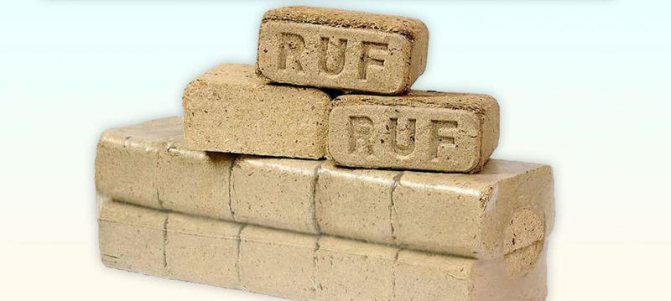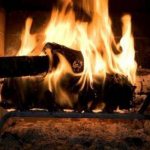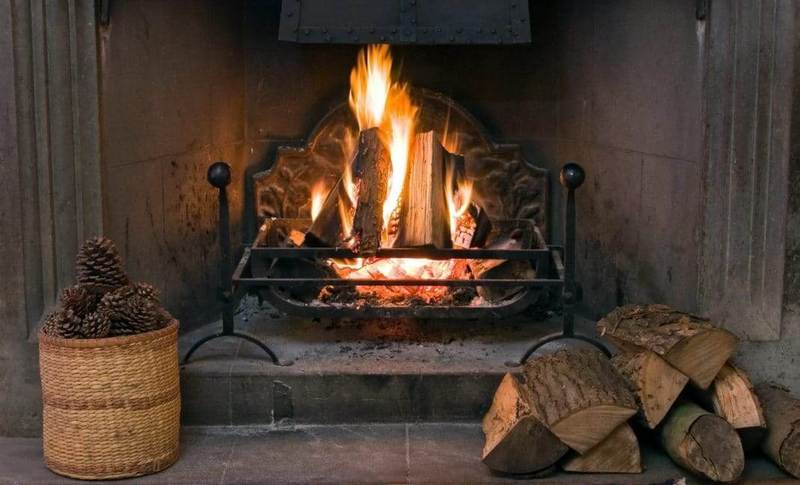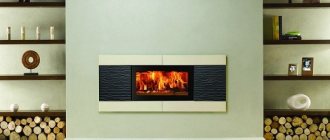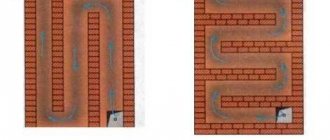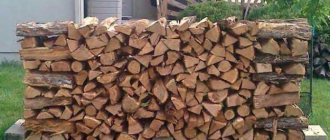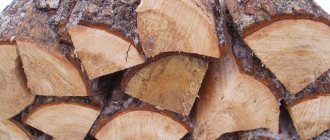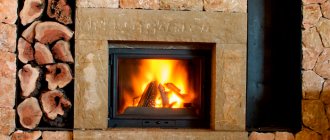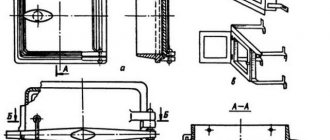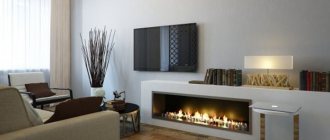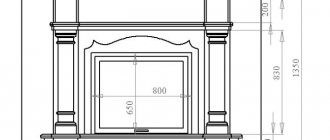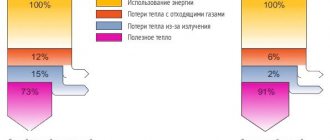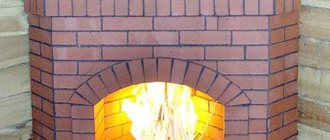Many owners of private houses choose fireplaces as an additional source of heat and decorative element. Whichever type you choose, the fireplace stove must be heated with the type of fuel to which it is adapted.
There are a huge number of fireplaces that use wood, coal, peat, gas and even electricity as fuel.
Fireplace combustion chamber with Euro wood
Choosing which wood is better drown fireplace, give your own preference to briquettes. Eurodrova is a fuel designed specifically for air heating. It has a lot of good qualities in comparison with ordinary logs:
- The flame during the use of briquettes flares up faster than in the combustion chamber with wood.
- Eurowood is made of pressed wood, the moisture content of the material will not be more than 11%. Thanks to this, the flame comes out the same and does not spark.
- One full load of briquettes will burn for 2 hours.
- In the process of burning Euro wood, the heat transfer is 30-50% higher than after using ordinary wood.
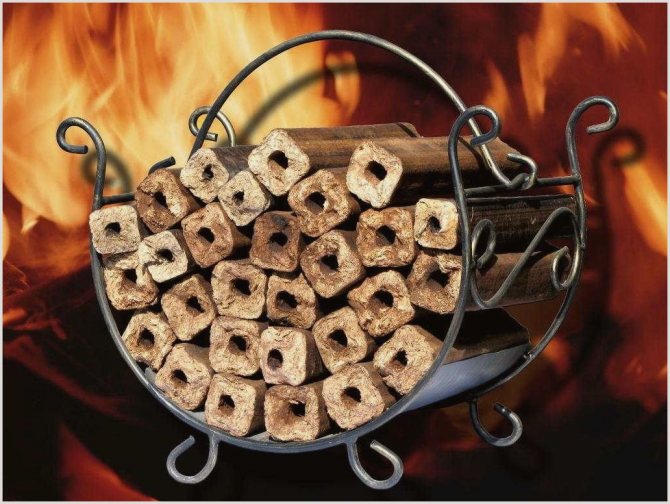
Eurowood is made of pressed wood or peat
Eurowood can be made of wood or peat. Peat coals take a long time to ignite, but the flame will also last twice as long in comparison with a wooden similarity.
Use of firewood as fuel
Nothing beats a real wood fire. Distinctive crackling and lively flames are only possible if real logs are used.
There are several invisible moments like drown
fireplace with wood correctly:
- It is necessary to comply with the rules for storing firewood. The room can be heated exclusively with dry wood, which contains as little moisture as possible. Firewood from trees that have just been felled will not work. It is necessary to use logs that have dried for at least a year. Such firewood is easy to distinguish - it has a much darker shade in comparison with other wood, there are several cracks on its surface. The burning process of dry wood is characterized by a clearly distinguishable crackling sound.
- The logs must be the same size. The thickness of the tree should be no more than 6-10 cm, otherwise the log will burn out badly. The length should be? parts of the furnace hole.
- For camera combustion fireplace
a horizontal way of laying firewood is used. Logs are placed in the furnace hole next to each other with an interval of 1 cm.The height of the bookmark should not be more than the 30 cm mark.
Another important sign of how to heat the stove is the choice of wood species for kindling the fireplace.
What wood is suitable for a fireplace combustion chamber?
How warm will the room be after combustion chambers
fireplace, how much soot and smoke there will be - it all depends on the type of wood for kindling. You need to know for sure which wood is better
drownfireplace... The following wood species are used for kindling:
- Hardwood. These include birch, hawthorn, pear and apple. It is a malleable wood that ignites easily. During combustion, some tar and soot are released.
- Hard rocks. For long-term burning, it is better to choose logs of oak, yew and beech. Such firewood is hard to chop, it takes a very long time to ignite. But the logs will also burn longer than other types of wood.
- Softwood. Elm, cherry, cedar and fir emit much less heat than other types of wood. Among other things, the logs smoke heavily, a significant amount of soot and ash is formed.It is necessary to refrain from choosing such embers if the chimney has a rectangular shape and a small hole. If the draft of the air duct is weak, smoke can fill up rooms.
- Conifers. To create a pleasant aroma in the room, pine and spruce logs are used. Coniferous trees burn quickly, but the flame comes out uneven, many sparks are formed. A significant amount of smoke and soot is also emitted. Due to the high resin content in conifers, coals can fall out of the fireplace, which is considered very unsafe.
- Cleansing rocks. These include alder and aspen. The wood does not emit smoke during combustion. From the use of firewood from alder and aspen, not only soot is not emitted, but also the chimney is cleared of soot. It is best to heat fireplace if used frequently with cleansing sticks, at least once every 14 days.
- Fragrant branches. Aromatic tree branches can be added to the fireplace flame, which will fill the room with a good smell. You can use the branches of fruit trees. The addition of juniper branches to the fire will bring healing and relaxing effects.
Preparing the stove for kindling
Before lighting the coal in the stove, you need to make sure that it is working properly. This is especially important for country houses, where the stove is heated very rarely.
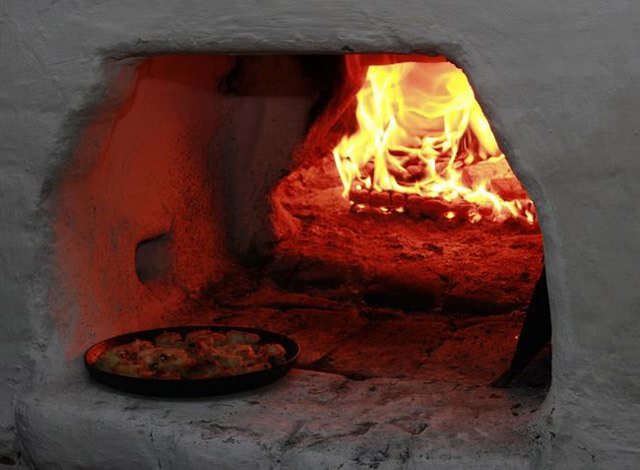

The check is carried out in the following sequence:
- We make an inspection of the stove to identify possible cracks in the brickwork. If there are any, this can cause smoke to enter the room, or the crack itself can grow over time, destroying the masonry more. Eliminate cracks by covering them with a solution of clay and sand.
- Now you need to check if there is whitewash on the pipe, at the level of the attic and the roof.
- Make sure that any flammable objects, in particular dry wood, are not closer than half a meter from a heated stove.
- It is advisable to start cleaning the pipes at least 2-3 times a month, provided that the oven is used continuously.
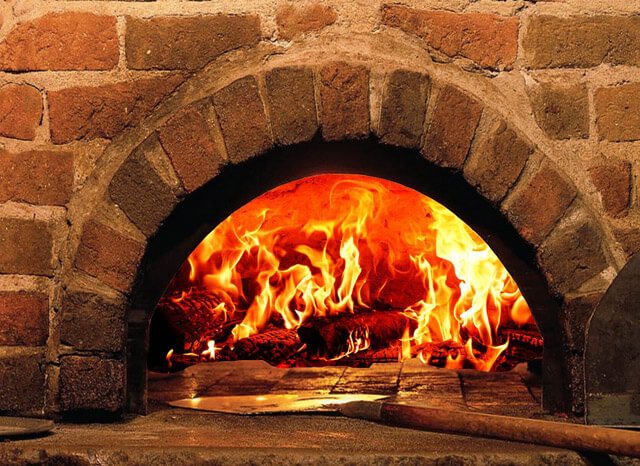

- Before stoking the stove with coal, it must be cleaned. Pour water into the slag and ash and remove all this with a poker into the prepared container. Any dry cloth will work to remove dust from the outside of the oven.
- It is forbidden to melt the stove with pieces of bitumen, plastics, building materials waste, and so on.
- It is not recommended to open the blower and the oven door at the same time.
- Try to heat the oven several times a day, no more than two hours, to avoid overheating.
- Coal for the furnace must be of medium size, dry and free of dust. When wet coal is heated, a lot of steam is released, which condenses on the surface of the pipe - after mixing it with soot, the structure is cooled.
- It is forbidden to ignite fuel with gasoline, kerosene and other flammable substances.
- The heated stove should always be supervised, especially when there are children and pets in the house.
Coal for fireplace combustion chamber
Coal fuel is rarely used for fireplaces. You need to know clearly how to do it right drown charcoal fireplace to make the stove last longer.
Stoke the fireplace
coal is possible only if there is a grate in the furnace. In the process of burning coal, a significant amount of ash is formed, which must be removed in time. Also, there should be a specialized cover near the fireplace that will close the furnace hole. The blower door must be kept open until the flame has ignited.
For camera combustion fireplace
both brown and stone are suitable
coal... It is necessary to select the variety, the combustion temperature of which is within 1500 degrees.


Coal only suitable for those fireplaces with a grate
Melt fireplace before setting coal, it is best to use small firewood. When they light up perfectly, lay down a layer of very small charcoal. It must be no thicker than 5 cm.After that, you can add a more massive coal
... In the furnace hole, the height of the bookmark should not be higher than 15 cm.
Coal dust can also be used to light a fireplace. To do this, roll the dust into paper or newspaper and moisten it a little. The bundles can be placed in the corners of the fuel port.
Furnace furnace with coal
Today, coal is a rather rare type of fuel for heating a private house. It differs from other types of fireplace fuel in that the maximum heat transfer does not occur during combustion. but during decay. But in order for your fireplace to serve you as long as possible, it is important to know how to properly heat the fireplace with coal.
To do this, you must comply with 4 conditions:
- Timely clean the fireplace from ash.
- The combustion hole must be a cover.
- The blower door must be kept open until the fire ignites.
- It is possible to heat the fireplace with coal only if there is a grate in the stove. And since burning coal requires a lot of air, the height of the grate is important. To exclude steel burning out, it may be necessary to replace steel grates with cast iron ones.
- Both hard coal and brown coal are suitable for the fireplace insert. We recommend choosing a type of coal with a combustion temperature of up to 1500 degrees.
Gas fuel for fireplaces
Some types of fireplaces are powered by a gas burner. In order to maintain the combustion process in a gas fireplace for 85 hours, one cylinder of liquefied gas is needed. The heat transfer during the combustion of gas is 2.5 times higher than during the use of solid fuel.
The most important thing to worry about when using gas fuel is the safety of storage and operation of gas cylinders. You need to worry about the following points:
- Gas cylinders should be placed in an individually isolated room with a supply-type ventilation system. This storage arrangement is necessary to prevent results from a suspected gas leak.
- The power of the fireplace determines which type of ventilation should be used in the fireplace. A combined ventilation system is suitable for a small fireplace. A high power oven must be equipped with a high draft chimney.
- In the room where the fireplace is located, there must be specialized sensors that warn of a very high level of gas in the air.
Two types of substances are used as fuel - propane-butane and network gas.
Pellet fired fireplaces
The pellet fireplace has a special design, which includes: a burner in the form of a grate bowl, a fuel hopper and forced air supply to the burner from below. Granular wood fuel (pellets) is supplied from the bunker compartment in portions.
This type of fireplaces is the most modern and has a system for automatic control and regulation of the supply of pellet fuel to the fuel compartment and the intensity of air intake.
Combustion processes are monitored and remote control of the fireplace is possible. There is a similarity to the designs of pellet boilers, but the fireplaces look more aesthetically pleasing and have transparent firebox covers, behind which the play of live fire is visible. Pellet fuel gives heat almost like coal, and one and a half times more than wood.


A pellet fireplace has advantages in design and can have a heat exchange water or air circuit, and be part of the heating system of a house or apartment. The efficiency is quite high - 85-90%. Chimneys are simplified and much lighter than for solid fuel fireplaces. A pellet-fueled fireplace model can be mounted in an apartment in a multi-storey building, provided that the chimney is properly drawn.This type of fireplaces is technologically advanced and modern, and pellet fireplaces are quite expensive.
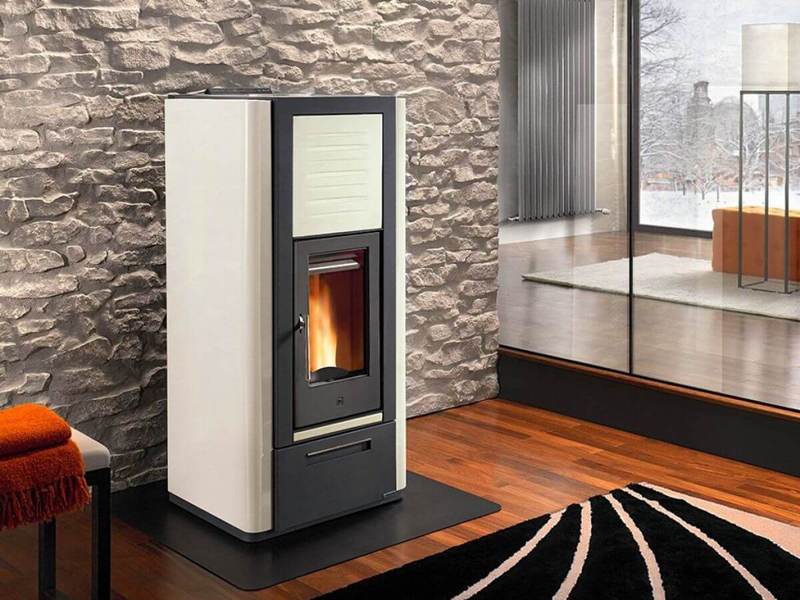

Biological fuel for fireplaces
Certain types of fireplaces run on environmentally friendly raw materials - biofuel. This liquid combustible material is made by converting biological raw materials into pure alcohol. During combustion, biofuel decomposes into carbon monoxide and superheated steam. Heat is generated during this process. The heat output from biofuels is significantly greater than the heat from a wood-fired fireplace.
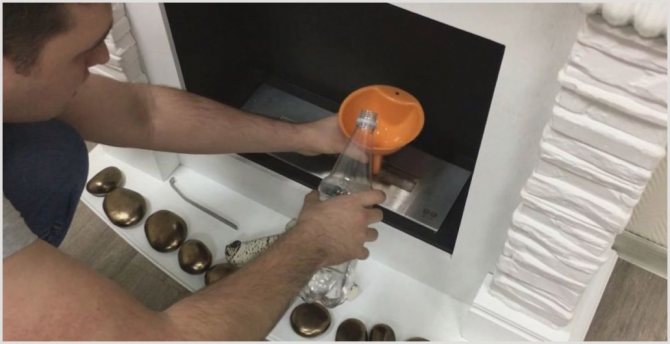

Biofuel is an alcohol-based liquid fuel
Biofuels have many good qualities. In the process of burning, even tongues of flame are obtained, soot and soot are not released. There is no smoke coming from the flame, and there is still no smell. To add the sound of the firewood crackling to the fire, a sea salt biofuel is released to perform a believable imitation.
Fireplace set
The first fixture that I bought for a fireplace, without even thinking whether it is necessary or not, is a standard fireplace set. They are different, but usually consist of a poker, scoop, cleaning brush and tongs. You can read more about fireplace sets here.
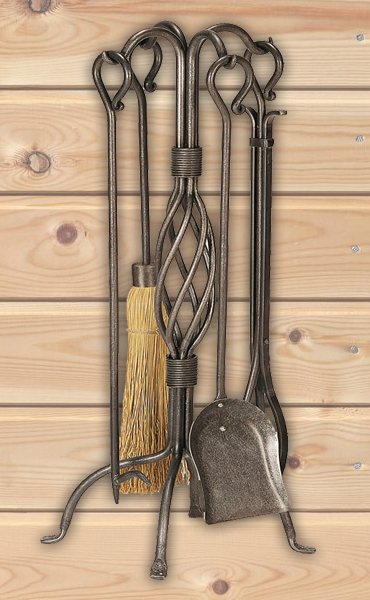

In my case, a poker and tongs are practically unnecessary. Since access is free. But the spatula and brush are very useful.
Safety rules for a fireplace combustion chamber
Fireplace is considered an interesting decorative element for every room. But you need to remember that everything where there is fire should be as harmless as possible. With the camera combustion fireplace
it is necessary to adhere to several mandatory rules:
- It is necessary to constantly inspect the combustion hole and chimney, assessing their integrity and the degree of contamination. If the fireplace is used more often, a lot of soot and soot forms on the walls of the air channel. Due to this, the draft of the chimney is weakened, and the smoke begins to partially make its way into the room. With a high concentration of carbon dioxide in the room, there is a danger of poisoning or getting eels.
- The ignition must be carried out in stages. First of all, use flammable materials such as small logs, sawdust and old newspapers. And only after they are very burned, add fuel for more heat.
- During the operation of the fireplace, the damper regulating the draft in the fireplace must be slightly open.
- Do not throw rubbish, painted logs or add flammable liquids into the fireplace. The smoke from such substances is toxic, which provokes poisoning.
It seems if in fireplace put more fuel, the flame will burn brighter and there will be more heat. But this is not at all correct. All the heat will go into the pipe. The fuel will burn in the same way as with a smaller setting. It is also necessary not to forget that if you fill the combustion chamber to the top with solid fuel, the walls of the fireplace can be damaged, which will reduce the operating period of the stove as much as possible, and at worst, lead to a fire. Because of this, it is best to use the fireplace fuel very carefully, following specific rules.
The best liquid for ignition
Further, as the furnace was operated, I realized that such a thing as liquid ignition was needed. There are many manufacturers. But from myself I will say that paraffin-based products set at zero temperature and become solid.
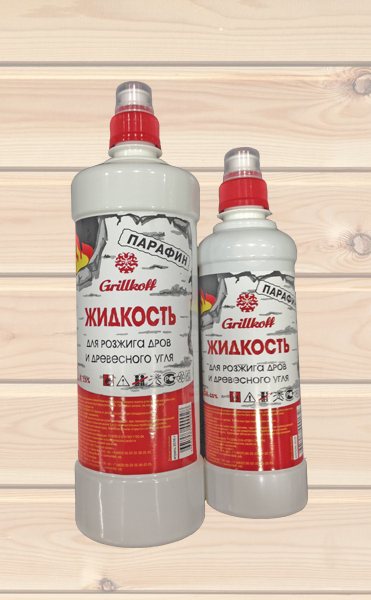

It happens that in winter you need to light a fireplace, but the liquid has frozen and it is impossible to use it. Therefore, you need to choose compounds that do not set in the cold.
Ignitions are liquid. They flare up very quickly. And there are thick, like fuel oil. They light up for a long time, they are not so easy to ignite. But then they burn effectively.
Fuel types
Do not forget that drown
fireplace you need only the type of fuel for which it is used.
It is best to apply dry hardwood. Firewood, which contains a lot of moisture, produces a lot of ash and smoke, and helps the formation of condensation.Dry wood is mostly dark in color, produces a clear sound and has cracks at the ends. Not so long ago, firewood that has been felled is never dry. The moisture content of such wood exceeds 50%. To get dry, they need to lie down all year, either indoors or in clean air. In the first variant, the humidity is reduced to 15%, and in the other - to 25%. It is recommended to keep firewood in a woodpile. To increase the speed of drying firewood, experts recommend putting firewood in each next row perpendicular to the previous row.
You can make a specialized firebox in the fireplace body - a niche in which firewood will be stored. In this situation, the problem of the safe location of the firebox becomes the problem, in order to avoid a fire. In most cases, it is done below, under the combustion chamber, while being isolated from the part for the firebox. If you are not sure that the fire safety technique will be followed, we advise you to keep the firewood away from the fire.
Firewood should be kept split. The thickness and length of the firebrands should be almost the same. A thickness of 6-10 centimeters is considered favorable. The length should be 3/4 of the width combustion chambers... The average length of the firewood should not be higher than 30-40 centimeters.
The highest heat output is found in hardwood: oak, beech, ash, birch, apple, pear, hawthorn and yew. Yew, beech, oak are hard to chop and melt. All other breeds are easy to prick, they burn beautifully. It should be said that slow combustion is inherent in hardwood.
Medium-hard wood is determined by the average calorific value. These are fir, cedar, elm, cherry. At the same time, firewood from fir, elm and cherry, burning, smoke very strongly.
Soft coniferous wood contains a lot of resin, it gives off a little heat, while leaving a lot of soot that settles on the inner walls of the fireplace. This wood splits easily, burns well, but very often sparks. Soft species include spruce and pine. The significant advantages of conifers include a good smell of burning firewood.
The most popular are birch firewood, which is easy to split, burns well and contains little resin. Plus, such firewood is the most affordable in the center of Russia.
Dry branches of cherries, junipers, pears, apple trees are often used for the fireplace because of the pleasant aroma that is formed during a fire.
Training
Before dealing with fire, the fireplace should be prepared for use. Even if you heat it daily, still do not neglect this step for your safety.
- It all starts with checking the chimney. The accumulation of soot on its walls can lead to uncontrolled combustion, that is, to a fire. Soot contains flammable resins and a substance called creosote. You need to get rid of them in a timely manner.
- Until the fireplace insert is full of wood, the draft should be checked. This is easy to do if you set fire to a piece of an old newspaper. In the presence of draft, the flame of the fire will clearly deflect towards the chimney.
Each owner independently determines what to heat the fireplace with, but there are a number of tips that you need to listen to. Each of us wondered why dry wood burns better. Damp wood contains moisture between the fibers. It is necessary to transfer the amount of heat for a long time so that it completely evaporates, and only then the wood will catch fire.
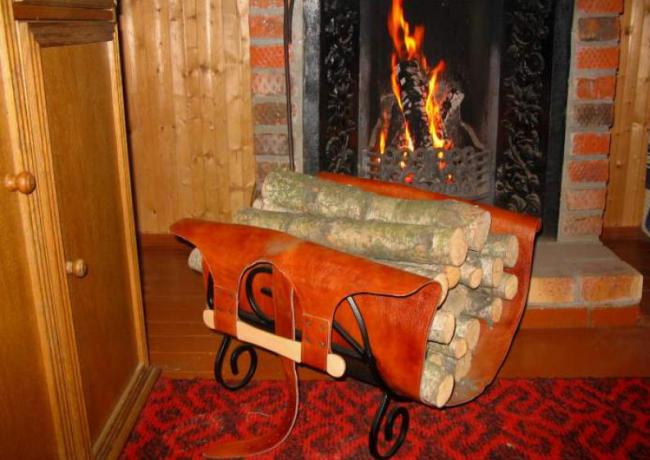

Dry firewood, ready to use
Therefore, if you have a wood-burning fireplace, then you should only use dry logs, preferably hardwoods. Of course, melting with a wet tree is possible, but this will require a lot of effort on your part. A newly felled tree is good for firewood, after a year of proper drying, so the owners of wood-burning fireplaces have pre-prepared stocks in the woodpiles.
Good to know: How wood-burning brick fireplaces are built for home and summer cottages
Certain requirements are also imposed on the external parameters of firewood. Their length should not exceed 40 cm and be about ¾ of the width of the firebox. As for specific breeds, preference should be given to those that give more heat. An example is beech, yew, oak, birch. It is not recommended to use conifers, as the resin in them will give a lot of soot and smoke.
How to heat a gas fireplace
Russian fireplaces that run on gas are shown by the following models: fireplace
"Amra" with infrared burner GIIV-1;
fireplace "Ray" - with a GII-3 burner.
It should be said about infrared burners. This kind of emitter is present in many Russian gas models of recent times. The emitter consists of a burner, a heat-resistant grate, which is located on top of a gas-fired burner. During the process combustion chambers
liquefied gas or network gas burns with a small blue flame, and the heat-resistant grate is heated to 800-900o. An infrared burner is effective for heating large areas. The most productive use of such fireplaces in areas with a climate of temperate latitudes. However, as additional heating, fireplaces with similar burners can be used in regions where the temperature is lower - 30o in winter.
Gas fireplaces
They can be installed both in a private house and in an apartment on any floor, subject to obtaining permission from the state supervision authorities.
To operate a gas fireplace, an exhaust device is required, which in this case replaces a full-fledged chimney. Gas fireplaces are automated and have a control unit and a thermostat to control the combustion temperature.
Gas combustion processes are controlled automatically and in case of an emergency or abnormal situation, the control system shuts off the gas supply.
Fuel - natural methane gas or liquefied propane-butane. The gas-fired fireplace has an atmospheric gas burner, the dimensions of the unit are quite compact, and the appearance of many models is very presentable and artistic.
In this case, there can be no problems with fuel procurement, but periodic cleaning of the fuel compartment and chimney-exhaust from soot deposits is necessary. A small amount of ash is also available.
The gas burns with a blue flame, and the color of the tongues of fire is not as bright and intense as when burning wood or coal. Therefore, gas fireplaces are decorated with imitation of live fire and wood-burning tabs.
There are many models of gas fireplaces, and some of them give a very high illusion of wood-burning fireplaces - the "wood" made of ceramics gradually heats up and takes on the color of red-hot burning wood.
Externally, a gas fireplace can be very similar to a wood-burning one and have all its natural aesthetics. But in terms of efficiency, gas fireplaces that are not equipped with infrared burners lag behind even wood-burning ones - only 60%, despite the calorific value of gas as a fuel (approximately 9000 kcal / m3). In this case, the firebox can only be closed.
Built-in low flame infrared burners and ceramic grates that generate intense infrared radiation (such grates can reach 850 degrees) make a gas fireplace design suitable for heating large homes in cold areas.
Cart is empty
From January 1, 2020, due to the increase in the VAT rate to 20%, the price of the overwhelming majority of goods will increase. Hurry up to buy a stove, fireplace, chimney or barbecue before the price increases!
Russian has started serial production of shell and marble fireplaces. Now you can purchase a Russian-made combustion chamber in a set with finishing.


Friends, in the warehouse, the wide fireplace combustion chamber MCZ Forma 115 misses its own future owner. This combustion chamber was purchased at the old rate and we have the opportunity to present a 20% discount on it.
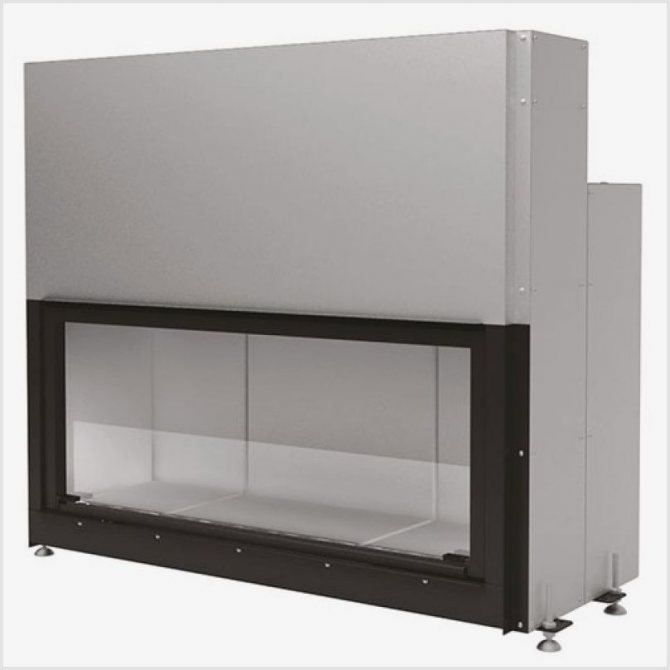

WHAT IS BETTER FIREWOOD FOR A CAST IRON OVEN? WHAT TO STUFF THE FIREPLACE WITH?
A fireplace or stove is not only attractive decorative details that are widely used in modern interiors, but, first of all, a good heat source released by burning wood. Fuel selection for combustion chambers a fireplace or wood-burning stove, affects not only the operating efficiency of the radiator, but also its appearance, service life and heat output. Due to this, questions about the choice of fuel for a stove or fireplace must be taken seriously. We will try to tell you in detail what types of fuel can be used to heat a stove or fireplace, and which is better to refuse to use.
WHAT IS POSSIBLE TO STUDY A FIREPLACE, OVEN?
Of course, a real classicism style fireplace has no association with anything other than wood. But, today's living conditions make their own adjustments and in addition to the aesthetic beauty of a living flame, the buyer also asks that when the fuel burns, a large amount of heat is emitted, and the operating period of the stove from one load of firewood should be as long as possible. All this became the reason that for fireplaces and long-burning stoves, production workers began to release long-burning firewood - pressed fuel, in structure resembling fuel pellets, but having a larger size. This begs the question: “Is it possible drown wood-burning stove with briquettes? " Pressed logs, euro wood, briquettes - all this is the name of one type of fuel made from shredded wood of various species, coal, peat and characterized by good heat return and a long burning period. However, the opka of a stove or fireplace with euro wood has a couple of properties. Let's consider them in more detail: wood briquettes flare up perfectly and maintain continuous combustion for 8 hours with full laying of the hearth. The briquettes will need to be lit in batches; first, you need to light up the minimum amount of firewood in order to give the pressed logs a great fire, and then add a new batch of briquettes. The burning time of euro wood from peat can be up to 6 hours. When burning any kind of briquettes, it will be briquettes in the form of fuel or wood briquettes, it is released almost 30-50% more than with a combustion chamber with ordinary wood, while the burning time of Euro wood is longer, almost half. What results in such a long burning time? When comparing briquettes for burning and firewood, it is necessary to understand the principle of the pressed fuel production process. During processing, moisture is completely removed from the crushed initial raw material (specific humidity will not be more than 11%). Then, very small particles are pressed so that there are no empty spaces between them, which provides a high density of briquettes and guarantees the same combustion without sparks, with very little smoke emission, which plays an important role for open fireplaces. During the manufacturing process, resinous inserts are also removed, thanks to this, pei and fireplaces are allowed drown briquettes even from coniferous trees. However, it should be borne in mind that the heat output of compressed softwood fuel is less than that of hardwood substitutes. All the same, choosing what drown fireplace, with real wood or briquettes, take into account that the pronounced aroma of burning wood and a pacifying crackle can only be when burning chopped wood.
WHAT FIREWOOD to use for the FIREPLACE?
Very good firewood, with a high efficiency and the highest heat capacity, is harvested from hardwood. Ideal for the camera combustion fireplace
Iil stove beech and oak, you can use acacia, aspen or any fruit tree. Beech and oak are deservedly considered "elite firewood". These rocks burn evenly and brightly, pleasing to the eye. During burning, there is a pleasant and even crackle. Beech firewood, in terms of its own heat output, is almost unmatched. Such characteristics are also distinguished by oak firewood. Oak firewood burns for a long time, almost does not emit smoke and does not spark. One drawback of these wood species for kindling a fireplace or stove is their high price.
The advantage of fruit tree species is the exclusive smell that enters the space of the room upon fire. It is customary to heat rooms for living with firewood from fruit trees, such as a apple tree, a pear, a plum. For some time, with regular use of "fruit wood" in the room, a stable smell of wood appears.
Alder and aspen firewood have a really extraordinary specificity. When they burn, neither smoke nor soot appears. In addition, the fire that forms when burning alder burns out the soot in the middle of the chimney, which helps to clean the surface inside the chimney and further settle the soot. With regular use of a stove or fireplace, it is recommended to heat them with alder or aspen at least once every couple of weeks to eliminate pollution of the chimney. Don't forget, most fires are actually due to the cause of excess soot formation in the middle of the chimney!
Regardless of the variety of woods, hardwoods are the most common and popular fuel. The most convenient way to heat a stove or fireplace is hazel, acacia, cherry, birch, maple. Due to the simple and cheap procurement of raw materials, the relatively inexpensive cost of the wood itself, these types of wood are considered the most optimal for combustion chambers stoves, wood-burning fireplaces and boilers. All these firewoods are perfectly pricked. Acacia is distinguished by the strongest heat emanating from the coals. Birch firewood burns perfectly even when damp, however, it is required to look after the constant flow of clean air and traction parameters, since the minus of oxygen when firewood from birch fires leads to the appearance of birch tar in considerable quantities, which helps the rapid contamination of the combustion chamber and the surface from glass.
Less suitable for combustion chambers
firewood is poplar and linden. Firewood has a lower density, burns quickly, while the heat release is minimal.
Regardless of the woody varieties, the necessary requirements are imposed on all firewood: they must be dry and not rotten.
WHAT CANNOT BE FURNISHED BY THE FIREPLACE?
For the lifetime of the fireplace, its durability and the appearance of the fireplace combustion chambers
with glass, the selected type of firewood has a significant effect. Apart from the recommended types of wood described above, there are types of fuels that are highly discouraged to burn in a fireplace or wood-burning stoves - these are coniferous wood. Coniferous wood is not dense, in the middle of it there are voids filled with resinous deposits. When the next pocket of resinous substance ignites, it occurs, in other words, a "microexplosion". Actually, therefore, when firewood from spruce or pine fires, sparks and coals jump out of the fireplace. Plus, from the pier it burns with the release of a considerable amount of soot, which settles on the walls of the combustion chamber and contaminates the sight glass.
Stoke the fireplace
pine spruce firewood is not worth it, for another reason. When burning spruce or pine, in the flue gases, apart from tar, there is a significant amount of soot with an oily structure. Soot settles on the surface inside the chimney, which leads to a gradual build-up of a dense layer on the inner void of the chimney pipe. Under the influence of temperature, the resinous layer is compacted and hardened, which makes it almost impossible to remove. In a similar way, the initial section of the chimney becomes narrower, which will then be poorly displayed on the draft. However, the main danger is that spontaneous combustion of soot in the middle of the chimney is quite common, which can cause not only the pipe to become unusable, but also cause a fire. Not recommended
drown fireplace and stove raw with wood. Wet wood is a source of soot, smoke and soot that settles on the walls of the chimney.All this reduces the service life of the hearth itself and the smoke removal system in general.
Fireplace operation - the most common mistakes
Solid fuel fireplaces
In order to burn anthracite, brown coal or logs in a fireplace and have good heating parameters, you will have to accept that the structure will be bulky - not only an aesthetic portal is needed, the correct combustion chamber and smoke removal are much more important. Chimneys for solid fuel fireplaces are quite complex and require supervision and periodic cleaning of soot.
There are strict requirements for the minimum chimney length for a solid fuel fireplace. In the case when it is technically impossible to maintain the minimum height of the chimney, forced exhaust ventilation systems are used for flue gas extraction.
For an apartment in a multi-storey building, a solid fuel fireplace is impossible in any design option (the main types are brick, with lined fireboxes or a cassette made of steel or cast iron). In theory, the top floors of houses can be equipped with fireplaces, provided the chimneys are removed through the roof, but "the appropriate authorities" will most likely not issue such permits to anyone; from the point of view of fire safety, such upgrades are too dangerous.
The operation of solid fuel fireplaces in cottages and country houses requires constant monitoring and regular cleaning of the firebox and chimneys: if improperly handled or blocked in the chimney, as well as unsuccessful designs and technical errors, the draft may deteriorate and even overturn, and, as a result, smoke the premises.
Wood
Than wood and coal fireplaces are heated: dry hardwood, the best and most expensive is oak. Also excellent firewood - ash, beech, alder and aspen. Apple and plum are a great option, with little soot when burning, good heat transfer and a pleasant aroma. Coniferous wood, even for closed fireplace inserts, is no good.
The heat output is average, with crackling, sparking and fire splashes, and a lot of soot. The large amount of essential oils and the special structure of coniferous wood makes coniferous logs unsuitable for fireplaces and stoves, and sometimes even dangerous. Exotic firing sparks can lead to fires or damage to floor coverings if the firebox is open.
Birch wood gives very good heat (the calorific value of birch is about a quarter stronger than that of many wood species). But a serious minus - a large amount of soot is formed, the chimney quickly clogs up. Aspen and alder logs have an interesting and useful property - if you heat the fireplace with them for about a week, you can burn out soot deposits on the inner surfaces of the chimney.
Thin logs - up to 120 mm in diameter - burn better and give more heat than thick ones. The calorific value of wood fuel, provided low moisture content and not too large logs, is approximately 3350 kcal / kg.
Coal fuel
To burn lignite and hard coal in a fireplace insert, it is necessary to have a firebox of a special design - a grate and a device that closes the firebox - a cover or doors - are required.
Not all grades of coal fuel are suitable for fireplaces, and the unit's passport must contain information that a particular fireplace model is adapted to use this fuel. High-temperature combustion coal (from 1500 degrees) is not used for fireplaces. In terms of calorific value, bituminous coal has the best characteristics - from 1000 to 7500 kcal / kg, for different grades. For brown coals, this value is less, up to about 4500 kcal / kg.
Peat
Peat briquettes are better than wood fuel in terms of calorific value - about 4000 kcal / kg. When using sod peat with a moisture content of up to 25-30%, you can have a heat output similar to wood.But the lack of lump and briquetted peat for fireplaces is a large amount of ash.
Fuel briquettes
Wood sawdust, shavings and even dust, like woodworking waste, have a plus in a low cost. Wood briquettes are pressed in the factory, the result is excellent heat transfer (calorific values like coal - 4500-5500 kcal / kg), high density - up to 1.0 tn / m3 and low humidity - up to 10%. When burning in an open fireplace insert, many types of wood briquettes burn too fast.
There are many types and brands of fuel briquettes, there are special types - impregnated to obtain a flame of certain colors.
